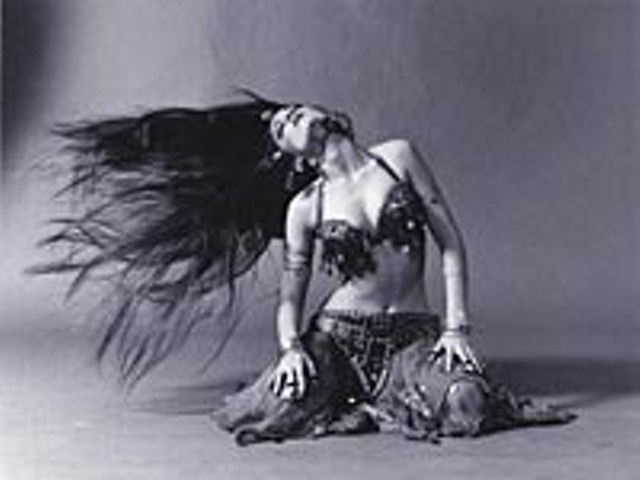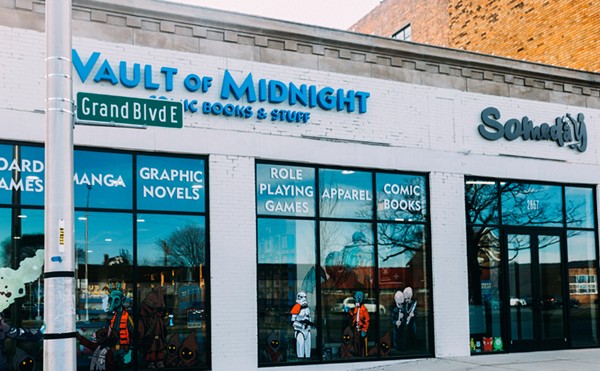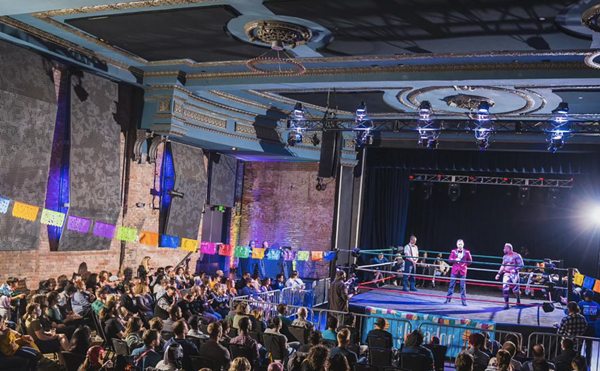According to the myth of the 36 Unknown, anonymous individuals exist in the world to assist mankind in times of peril. They can be found in firefighters and medics, mail carriers, clerks, cousins, bosses, bus drivers or neighbors. Any individual — someone we know or one of the nameless faces we encounter everyday — may have this noble purpose, unbeknownst to them.
Native Detroit photographer Todd Weinstein began to discover these spirits, as he calls them, while working on a project at the invitation of the German government in 1994. He glimpsed entities hidden among rocks and objects, eyes looking back from pockmarked concrete, faces in rubble, figures reflected through natural phenomena. He captured them in a series of photographs titled The 36 Unknown.
Weinstein’s collection will be exhibited in the new Holocaust Memorial Center in Farmington Hills. The series is installed in the museum’s International Institute of the Righteous, the wing devoted to moral and ethical issues, altruism, and people’s courageous self-sacrifice helping others during dire circumstances.
“The Mourner” shows a yield sign leaning and weeping blackened tears. “The Cantor,” a gaping hole in a wall, appears to wail through alleyways. A dignified bearded profile, conjured from a craggy hillside, could be the King of Denmark who wore a yellow Star of David in sympathy with Jews during World War II. These abstractions — a bolt for an eye and rebar lips — captured through Weinstein’s uncanny lens on streets and buildings in Germany, Poland and Israel, could embody anyone, calling us all to noble deeds.
The parable of the 36 Unknown is taken from the Jewish Talmud and Kabbalistic lore, and seems as relevant today as in ancient times. These tzaddikim in Hebrew and lamed vov-niks in Yiddish, are also found in other beliefs, such as the Immortal Sages of the Yogic tradition. Similar to the Golden Rule found in many faiths, the myth’s message advocates treating everyone with kindness.
“I began seeing these spirits in Auschwitz, though I didn’t know it was the 36 Unknown,” Weinstein explains. “I’m not sure how it came through me.”
While working on a project entitled Darkness into Light: the Re-emergence of Jewish Life in Germany, the photographer joined 1,600 journalists documenting the commemoration of the 50th anniversary of the liberation of Jews from concentration camps.
“As I walked around, they appeared to me. The first was ‘The Storyteller.’”
The spirit is illustrated in a corroded door latch lying on a railroad tie — its eyes staring, its mouth wide.
A Polish friend got Weinstein through a locked passage in Auschwitz’s Block 11 to the “killing wall.”
“That’s where I saw ‘The Lovers’ Farewell,’” he says of a moving picture of two stones facing each other, gazing in silence.
When the photographs were initially presented to Rabbi Charles H. Rosenzveig, executive vice-president of the Holocaust Memorial Center, the rabbi asked, “What makes you think the 36 were in these places?”
“What makes you think they weren’t?” Weinstein responded. It’s an understandable quandary. An aspect of this myth considers not all 36 are always present.
“At the camps I got into an altered state. You’re paying respects,” says the photographer. “I kept asking myself, ‘How could this have happened?’ Nothing rational came to mind. ‘What could have possibly saved the world?’
These emanations, encountered at places of remembrance, inspired by the Holocaust and informed by the myth, compelled Weinstein to express something beyond the horror of the Nazis. He thought a healing piece of the story was missing.
His haunting and captivating photos portray both sorrow and solace. Weinstein discovers meaning through the eloquent silence of his lens.
An artful approach to the Holocaust can touch feelings words can’t convey. The power of myth reaches deeper. Combining these elements makes the unspeakable available emotionally.
“I designed this work to be part of the hope,” Weinstein says. “It’s an attempt to find a way to move on.”
Weinstein’s Detroit history goes way back. Shooting Grand Funk Railroad and Mick Jagger for Creem magazine seems an auspicious start for an aspiring photographer whose father owned The Mump rock club in the late ’60s.
After graduating from the Center for Creative Studies, Weinstein moved to New York City and developed his craft with mentor Ernst Haas, the acclaimed documentary photographer who has been called “the father of color photography.”
In the introduction to Weinstein’s Personal Journalism book of 1985, Haas said his former protégé possessed “a heart, a mind, a soul, and a well-reacting trigger finger to serve the eyes of the beholder.”
These qualities allow him to capture the essence of a moment when “the outside reveals the inside,” Haas wrote.
Over the last 30 years, Weinstein’s work has been exhibited throughout the United States and Europe, in collections at the Metropolitan Museum of Art and the Museum of Modern Art in New York City and the Detroit Institute of Arts. Despite the photographer’s wide audience, he’s thrilled to be part of the Farmington Hills Holocaust museum.
“To share these last ten years of my life brings the fulfillment to fruition, liberating it from me to live on its own,” he says.
New museum
Previously tucked discreetly into a corner of the Jewish Community Center in West Bloomfield, the first American Holocaust museum — founded 20 years ago by Rabbi Rosenzveig — has now moved into a striking structure in a highly visible location in Farmington Hills. Detroit’s new Holocaust Memorial Center joins more than 50 similar institutions around the world from Australia to Texas, Berlin to Japan.
The anticipated $17 million facility follows a thematic timeline with the addition of the Museum of European Jewish Heritage and the International Institute of the Righteous as well as documentation of the Holocaust.
The award-winning building, designed by Neumann/Smith & Associates of Southfield, has met with controversy.
“The previous museum was very powerful on the inside,” says architect Ken Neumann. “But from the outside, you didn’t even know it was there.”
Some critics wish it hadn’t left the original site for the conspicuous placement in the congested retail corridor, and survivors feel the facade’s resemblance to the camps is too raw and harsh a reminder.
“It’s not an easy building,” the architect admits. “But it’s meant to tell their history. It shouldn’t be joyous.”
The basic design emphasizes the enclosure of Jews with deliberate use of sharp angles and hard materials. Stretched cables symbolize barbed wire fencing, gray vertical-striped siding represents the uniforms; the guard-tower-like entry even has a gun slit. Stark red brick with matching mortar expresses violence and bloodshed — as opposed to warm homey brownish brick.
“We’ve taken real care to provoke, in a visceral way, our response to the iconography of these hideous places. No one drives by without being taken aback, and that’s good,” Neumann says. The landscaping echoes the message through gnarled trees and wild grasses instead of manicured lawn. The traffic circle, designed by Randy Metz, has intercepting railroad ties — like the trains that crossed Europe leading to camps — forming Star of David patterns.
The museum redeveloped and enlarged the Old Orchard movie house to provide four times the exhibit space of the old center. Theater floors were flattened and the box office was gutted to build a lobby, galleries, and meeting halls. The architectural firm also designed the Detroit Science Center upgrade, the National Corvette Museum, and the upcoming Jim Crow Museum at Ferris State University.
Upgraded exhibits include high-tech audiovisual presentations created by a husband and wife team, Houghton/Kneale, a British outfit that designed the first space and worked on the Simon Weisenthal Museum of Tolerance in Los Angeles. Enormous amounts of research and documentation in the center required approval from a gauntlet of professors, and many copyright clearances, causing delays in the museum’s opening.
The first gallery presents the history of Jewish migration, celebrating the customs and impact of Jewish contributions of the 19th and 20th centuries. Witnessing the legacy of Jewish artists such as Chagall and Modigliani, writers such as Proust and Kafka, composers from Mendelssohn to Schoenberg, scientists including Freud and Einstein, and philosophers such as Marx and Spinoza, it’s hard to conceive of the countless dead from the Nazi’s “final solution.”
Three murals by Anatoliy Shapiro, a Farmington Hills artist, show various scenes depicting Eastern European life in the 1920s and 1930s, including a typical village street re-created from his childhood memories. Between the brushstrokes, the painter illustrates the wretched consequences of fascism — the blacksmith resembles the artist’s father and his brother rides a tricycle. Both were killed in the Holocaust.
The next section graphically outlines the economic events and social ills leading to the rise of Hitler and anti-Semitic policies. Visitors move through a barrage of displays on the atrocities — from relocation to internment to genocide. A tattered yellow Star of David patch with the identifying Hebraic “Jude,” worn by Jean Hulmereich of Paris in Auschwitz, turns an artifact into a person’s pain.
Literally and figuratively, descending into this “abyss” creates an experience that intentionally underscores the darkness — black walls, floors and ceilings amplify the impact. Walking single file across a bridge suspended through a gallery offers a chilling effect. An empty gas canister hangs in midair.
“It’s a bit scary,” admits Neumann. “But nothing is as gripping as listening to a survivor describe the experience. No one could make a building hard enough to tell that story.” Tours for hundreds of thousands of students will conclude with meeting one of Michigan’s approximately 2,000 Holocaust survivors.
The grave, somber rooms of the historical exhibit eventually lead up to a white, day-lit, elliptical building, expressing the positive, uplifting ideas of the Institute of the Righteous. Under six 17-foot-high conical skylights that glow golden at night — one for each of the 6 million Jews who died in the Holocaust — stand portraits of role models who provided aid to Jewish people, such as Oscar Schindler, Swedish Ambassador Raoul Wallenberg, the French people of Chambon-Sur-Lignon.
“The Mission,” a stirring artwork by Toronto artist Dubie Arie, who escaped Poland in 1939 to live in Israel, presents a historical account of the Jewish experience — from the birth of a nation and destruction of the temple to struggles and redemption.
On leaving the center, the Eternal Flame burns in memory of Holocaust victims, listing camp names and the numbers of Jews killed in 21 countries from Norway to Greece. Following this 800-year-plus journey, the center’s goal becomes clear: By illuminating the past, we can hope for social change.
Roberta Cruger is a former Detroiter living in Seattle. She’s written for Salon.com, L.A. Times Magazine, The Village Voice, and was a founding editor of Creem magazine. E-mail comments to [email protected].





